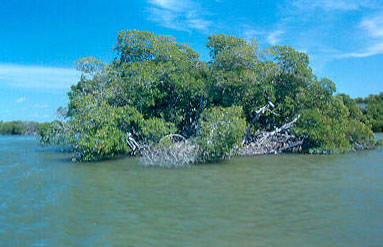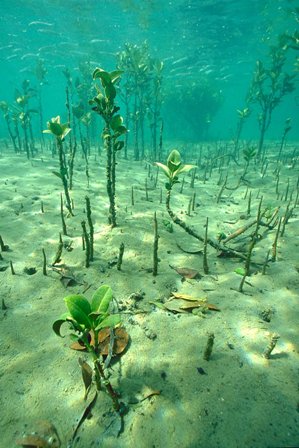Discover Florida Nature
It's time to explore the natural Florida


|
|
|
|
|
 Mangroves
are part of the Coastal Ecosystem. Florida's coastal ecosystems are one
of the greatest assets that Florida has. With more coastline than any
other state in the contiguous United States, they are a source of both
economic, environmental and recreational benefit. People come from all
over the world to visit the beautiful Florida beaches. In addition to
people
sea turtles also come from all over the world to lay their eggs on
Florida's Atlantic coast, one of only a handful of places in the world
that they come. Mangroves are one of Florida's true natives. Three types
of mangroves are found in Florida: red, black, and white. They cover
south Florida with a verdant and life-giving shield that nurtures marine
organisms of all kinds, provides nesting sites for shore birds, and
shelters juvenile fish. Mangroves
are part of the Coastal Ecosystem. Florida's coastal ecosystems are one
of the greatest assets that Florida has. With more coastline than any
other state in the contiguous United States, they are a source of both
economic, environmental and recreational benefit. People come from all
over the world to visit the beautiful Florida beaches. In addition to
people
sea turtles also come from all over the world to lay their eggs on
Florida's Atlantic coast, one of only a handful of places in the world
that they come. Mangroves are one of Florida's true natives. Three types
of mangroves are found in Florida: red, black, and white. They cover
south Florida with a verdant and life-giving shield that nurtures marine
organisms of all kinds, provides nesting sites for shore birds, and
shelters juvenile fish.SUBSTRATE: Waterlogged, anaerobic, brackish sediment deposited by freshwater runoff and tides, and increased by organic matter from mangroves. TOPOGRAPHY: Low-lying, intertidal zone, with some extensive to irregularly flooded higher fringe areas. VEGETATION / ALGAE: Three species of true mangroves—red mangrove dominates middle and lower portions of intertidal and upper subtidal zone; black mangrove dominates upper intertidal zone and irregularly flooded higher elevations; white mangrove is found in patches in higher parts of intertidal zone; buttonwood is often on upland fringe; all grow as trees or large shrubs. FAUNA: Valuable habitat for wide range of invertebrates and vertebrates, including 220 fish and 181 bird species; habitat of endangered American crocodile and Florida manatee. PROCESSES / DYNAMICS / ABIOTIC FACTORS: Limited by temperature to tropics and subtropics; fluctuations of water level necessary for proper development; salt water excludes potential plant competitors; hurricanes may prevent mangroves from reaching maximum heights. NEGATIVE IMPACTS: Thousands of acres have been destroyed and replaced with filled and developed land; can be seriously damaged by oil spills and herbicides; both sport and commercial fisheries decline when mangroves are destroyed.  Mangroves
are one of Florida's true natives. They thrive in salty environments
because they are able to obtain fresh water from saltwater. Some secrete
excess salt through their leaves, others block absorption of salt at
their roots. Florida's estimated 469,000 acres of mangrove forests
contribute to the overall health of the state's southern coastal zone.
This ecosystem traps and cycles various organic materials, chemical
elements, and important nutrients. Mangrove roots act not only as
physical traps but provide attachment surfaces for various marine
organisms. Many of these attached organisms filter water through their
bodies and, in turn, trap and cycle nutrients. Mangroves
are one of Florida's true natives. They thrive in salty environments
because they are able to obtain fresh water from saltwater. Some secrete
excess salt through their leaves, others block absorption of salt at
their roots. Florida's estimated 469,000 acres of mangrove forests
contribute to the overall health of the state's southern coastal zone.
This ecosystem traps and cycles various organic materials, chemical
elements, and important nutrients. Mangrove roots act not only as
physical traps but provide attachment surfaces for various marine
organisms. Many of these attached organisms filter water through their
bodies and, in turn, trap and cycle nutrients.The relationship between mangroves and their associated marine life cannot be overemphasized. Mangroves provide protected nursery areas for fishes, crustaceans, and shellfish. They also provide food for a multitude of marine species such as snook, snapper, tarpon, jack, sheepshead, red drum, oyster, and shrimp. Florida's important recreational and commercial fisheries will drastically decline without healthy mangrove forests. Many animals find shelter either in the roots or branches of mangroves. Mangrove branches are rookeries, or nesting areas, for beautiful coastal birds such as brown pelicans and roseate spoonbills. Mangroves also filter water and maintain water quality and clarity. Worldwide, more than 50 species of mangroves exist. Of the three species found in Florida, the red mangrove is probably the most well-known. It typically grows along the water's edge. The red mangrove is easily identified by its tangled, reddish roots called "prop roots." These roots have earned mangroves the title, "walking trees." The mangrove appears to be standing or walking on the surface of the water. Mangroves are common as far north as Cedar Key on the Gulf coast and Cape Canaveral on the Atlantic coast. Black mangroves can occur farther north in Florida than the other two species. Frequently, all three species grow intermixed. |
|
|
Advertise | Privacy Statement | Dog Encyclopedia | Video |Contact Alaska Nature| Michael Arnold Art |
|